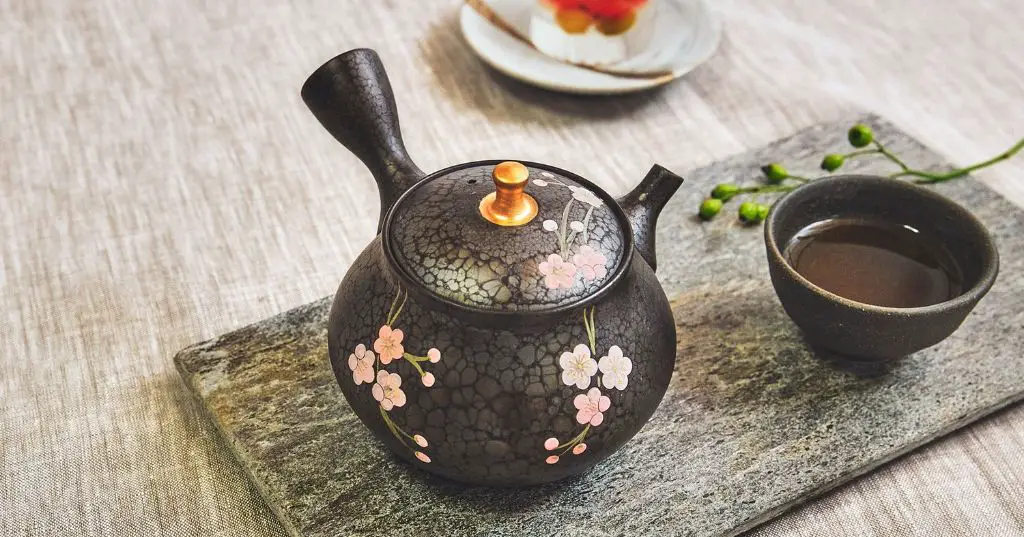What Is A Japanese Teapot?
A Japanese teapot, known as a kyūsu, is a traditional teapot originating from Japan. It is mainly used for brewing and serving Japanese green tea. The kyūsu has a simple, yet elegant design that reflects Japanese aesthetic principles. It is an integral part of the Japanese tea ceremony and reflects the care and mindfulness that goes into the preparation of matcha green tea.
The kyūsu is designed specifically for brewing Japanese green teas like sencha, gyokuro, and matcha. It is crafted to allow precise temperature control and even infusion during brewing. The small size, curved spout, and handles are optimized for serving the tea in small Japanese tea cups known as yunomi.
History
The kyusu teapot originated in China, where teapots similar in style were used to brew and serve tea. However, the kyusu evolved and became refined in Japan as tea culture flourished there.
Some of the earliest examples of kyusu-style teapots date back to the 16th century in Japan. These early teapots were made from ceramics and had a side handle and pouring spout. As Japanese tea masters developed detailed rituals and procedures around the preparation and serving of tea, the design of the kyusu teapot became more specialized and tailored for Japanese tea service.
Sources:
[1] https://yunomi.life/blogs/ocha/history-behind-the-japanese-side-handled-kyusu
[2] https://www.akazuki.com/blogs/news/short-history-of-japanese-iron-kettles-teapots
Types
There are several major types of Japanese teapots, distinguished by their design, material, and intended purpose:1
The kyusu is the most common and versatile teapot for brewing Japanese green tea. It is made from clay or porcelain and usually has a large globular body with a handle on the side. Kyusu are designed for brewing sencha and other loose leaf teas.2
The houhin is a small, refined teapot used for brewing thin Japanese green teas like gyokuro. Houhin are delicate and often have beautiful hand-painted decorations. They are made from porcelain or ceramic.3
The shiboridashi has a tall, slender shape optimized for rapidly cooling the boiled water before steeping sencha. It is made from glass, ceramic, or stainless steel.
The dobin is a large teapot designed to brew and serve fukamushi sencha in the Kyoto style. Dobin have a curved spout and are made from clay.
In addition to these main types, there are also tetsubin cast iron teapots and modern chaho teapots made from stainless steel or glass.
Design
Japanese teapots come in a variety of distinctive shapes and sizes, each designed for specific types of tea. Some of the most common features include:
Spouts – The thin, curved spout is designed to pour water smoothly without dribbling, which is essential for the Japanese tea ceremony. Spouts may be long or short. Long spouts are better for precision pouring.
Handles – Teapots usually have a handle on one side. The handle may be thick and easy to grip, or thin and cylindrical. Thicker handles provide stability while thin handles allow the teapot to be held using just the thumb and forefinger.
Lids – Most Japanese teapots have a fitting lid to maintain the temperature of the water inside. The lid often rests loosely on top.
Shapes – Some common shapes are cylindrical, bulbous, or quadrilateral with a flat base. Cylindrical and bulbous pots are easier to handle while flat-bottomed pots sit steadily on the table.
Spouts and handles are positioned to allow for optimal pouring. The flow of water when pouring is precisely controlled in traditional Japanese tea ceremony.
Key design features create functionality paired with elegant simplicity emblematic of Japanese aesthetic principles. Form follows function in Japanese teapot design. (https://senchateabar.com/blogs/blog/japanese-teapot)
Decoration
Japanese teapots are known for their beautiful and intricate decorations. Some of the most common decorative techniques include:
Makie – This lacquer technique involves sprinkling metal powders, often gold or silver, onto wet lacquer to create delicate designs. Makie decorations on teapots often depict nature scenes with flowers, birds, or seasonal motifs.
Raku – A style of handmade pottery traditionally used in Japanese tea ceremonies. Raku ware involves removing pots from the kiln while still red hot and placing them in containers with combustible materials to create crackled, unpredictable glazes.
Enamel – Vibrant enamel glazes in red, blue, green and other colors are painted onto the clay before firing. Japanese enamelwork is known for its high quality and precision.

Carving – Intricate designs are carved by hand into the clay body before firing. Popular carved designs include chrysanthemum flowers, waves, trees, mountains, and calligraphy.
Gold embellishments – The use of real gold is a hallmark of high-quality Japanese teapots. Gold may be used in leaf form, powdered form, or molten to create delicate accents.
Purpose
Japanese teapots, known as kyusu, serve an important purpose in the Japanese tea ceremony. The shape and design of the kyusu is intended to brew and pour green tea gracefully during the ceremony (Source).
The kyusu’s small size, curved spout, and side handle allow the server to pour the tea in a controlled, elegant manner into the waiting cups. This adds to the contemplative nature of the tea ceremony.
In addition to tea ceremonies, kyusu are also used for brewing and serving sencha (green tea) during informal tea breaks or gatherings. The kyusu’s design makes it well-suited for steeping loose leaf sencha (Source).
So in summary, the intended purposes of the kyusu are to facilitate the Japanese tea ceremony, as well as brew and serve Japanese green tea in daily life.
Notable Examples
Japan has a long tradition of ceramic artistry and teapot making. Some of the most famous and renowned Japanese teapots include:
Banko-yaki – These teapots originate from the Banko region of Japan and are made from reddish clay. Banko teapots are known for their rustic and textured appearance. They often feature indented patterns and simple painted designs. According to The Ultimate Guide to Japanese Teapots, Banko teapots are admired for their charming irregularities.
Tokoname-yaki – Coming from the Tokoname region, these teapots are made from iron-rich clay and fired at very high temperatures. Tokoname-yaki teapots have a smooth, refined surface and often feature minimalist designs. They are appreciated for their elegant shapes and earthy tones. As stated by Choosing the Best Traditional Japanese Teapot, Tokoname teapots are frequently used in Japanese tea ceremonies.
Seigan Yamada – Considered one of Japan’s most famous teapot makers, Seigan Yamada (1925-2009) perfected the art of hand-molding teapots known as nerikomi-gata. His signature teapots feature bold colors, inventive shapes, and embedded glass, clay and metal fragments. Yamada elevated the humble teapot into an expressive art form. His works can be found in major museum collections.
Other influential teapot makers include Tatsuzo Shimaoka, Kitaoji Rosanjin, and Ogata Kenzan. Their creative vessels demonstrate the diversity and artistry of Japanese teapot craft.
Collecting
Japanese teapots are highly collectible items with examples dating back hundreds of years. According to the Japan Box, “In Japan, ceramics are national treasures”. Collectors search for teapots made in certain styles, time periods, regions and by famous artists or kilns. The town of Tokoname is especially known for producing collectible teapots for centuries.
Teapots can be found at auction houses, antique stores, estate sales, and online marketplaces. It’s important to examine teapots closely to authenticate age and origins. Experts recommend looking at factors like the clay color and thickness, glaze style, markings, spout and handle shape. Genuinely old and rare teapots often have small imperfections that indicate handcrafting. Typical wear like slight discoloration also helps confirm age.
Caring for vintage teapots requires gently washing by hand and avoiding harsh cleaners or scrubbing. Store teapots somewhere climate-controlled and away from direct light. Be very cautious heating older teapots on stoves, as quick temperature changes can cause cracking. Rotate displaying and regularly airing out teapots helps preserve them.
Influences
The Japanese teapot, known as a kyusu, has had a significant influence on tea culture and teapot design around the world. Japanese aesthetics and minimalism have inspired the creation of teapots in many other cultures.
One of the biggest impacts has been on Chinese teapot design. Historically, Chinese teapots were made from porcelain and emphasized decorative patterns. After trade opened up between China and Japan, Chinese potters began being influenced by the simple, functional style of Japanese kyusu teapots and incorporating that aesthetic. This included using clay instead of porcelain, focusing on subtle glazes over bright patterns, and making teapots with a single handle and spout on one side like the kyusu.
Modernist designers in Europe during the early 20th century found inspiration in ancient Japanese arts and crafts. The Bauhaus art school embraced Japanese pottery and adopted simple, geometric teapot shapes made from earthenware clay. Many contemporary European teapot designs still reflect this Japanese influence through their minimalist forms.
The kyusu’s one-sided handle and spout design has impacted tea cultures worldwide. This off-set handle allows tea leaves to move freely as the teapot is tilted, infusing the tea properly. The kyusu’s functionality has led potters from the U.K. to Turkey to Morocco to include its one-sided handle in their regional teapot designs.
Beyond the physical design, the Japanese tea ceremony has influenced how many cultures approach the tradition of tea drinking. The meditative, spiritual nature the kyusu teapot embodies has helped spread an appreciation for the tranquil, ceremonial aspects of tea around the world.
Conclusion
Japanese teapots are an important part of Japanese culture and history. They represent the Japanese tea ceremony, which emphasizes simplicity, tranquility, and living in harmony with nature. Teapots are valued for their elegant designs, decorative techniques like enamelwork and lacquer, and masterful pottery craftsmanship.
The various regional styles of Japanese teapots showcase local aesthetics and artisanship from different parts of Japan. From rustic country pots to refined urban designs, Japanese teapots display remarkable diversity while adhering to shared principles of form and function.
Collecting vintage Japanese teapots provides a glimpse into Japan’s rich cultural heritage. As functional art objects, they exemplify Japanese ideals of artistry, minimalism, and craftsmanship. Their designs continue to influence modern ceramic artists and teapot makers around the world.
Japanese teapots are more than just vessels for brewing tea. They are an emblem of a ceremonial tradition that shaped Japanese culture. Their ongoing study and appreciation preserve this legacy for future generations.




